2016-02-29

Janos Vaszary (1867 – 1939) mostly did portraits in oil. However this image is a departure from his usual, more colorful pieces. This monotone image shows both complexity and simplicity at the same time.
2016-02-28

1963 was a busy year for many, many reasons. In Iran, women won the right to vote, while in the U.S. George Wallace took the governorship of Alabama, proclaiming “segregation now, segregation tomorrow, and segregation forever!” The European Court of Justice established the principle of “direct effect”, while the U.S. embargoed Cuba and Fidel Castro visited the Soviet Union. In New South Wales the indigenous people won the legal right to drink, while in the U.S., swim classes in schools and YMCA’s were regularly held in the nude. In London 70,000 marched against nuclear weapons. In Jackson, Mississippi Civil Rights worker Medgar Evers was assassinated just hours after John F. Kennedy delivered his Civil Rights speech, and Martin Luther King delivered his “I Have A Dream” speech in Washington. The Aricebo Observatory started operation and Valentina Tereshkova became the first woman in space. The nation of Malaysia was formed, Nigeria became a republic, Kenya and Xanzibar became independent, and there was a coup in South Vietnam. Nine hundred people died when an earthquake destroyed the village of Marj, Libya; 1,500 died when Mount Agung in Bali erupted; 1,800 died in an earthquake in Skopje, Yugoslavia; 2,000 died when a landslide caused a flood at the Vajont Dam in Italy; and Hurricane Flora killed 7,000 in Cuba and Hispanola. In August Patrick Bouvier Kennedy, infant son of U.S. President Kennedy died, and was followed in death in November by his father, who was assassinated in Texas.
The art world was not resting while all this happened. As in any time in the modern era, new art movements were starting (and ending). New realism, magic realism, minimalism, hard-edge painting, Fluxus, Happening, video art, psychedelic art, conceptual art, graffiti, junk art, performance art, Op Art, lyrical abstraction, process art, Arte Povera, photorealism, and land art were all new and emerging movements, and other art movements were underway or forming. As any society changes, its art will also change, both reflecting and driving the evolution around it. People see the art and modify their behavior, and artist see the change in behavior and thought and modify their art. Older pieces are swept aside, placed in storage, or simply destroyed so that newer pieces can take their place, a fate possibly in store for today’s example. To many today 1963 is a history they never experienced, while for others it was their formative years. 2016 is also going to be a formative year, as will 2017 and any other year that follows. What will you be doing?
2016-02-27
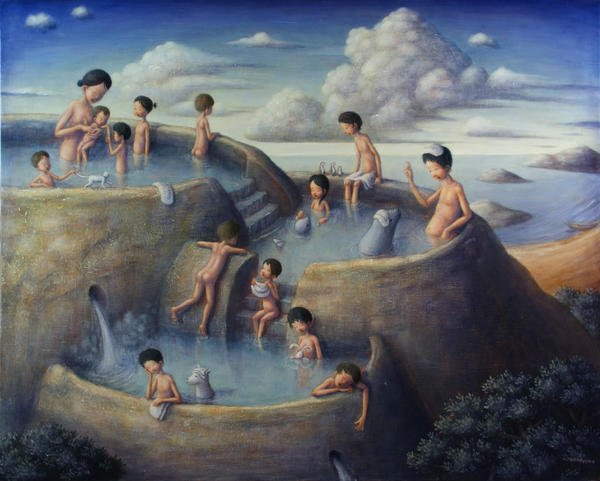
“There is no finer investment for any community than putting milk into babies.” Winston Churchill
The education of children is one of the highest purposes of any society. Children are uniquely suited to learn; indeed, it is their sole occupation for at least the first five years of their lives and occupies a large part of their entire childhood. Even play is effectively un-organized education. The first lessons a human learns have nothing to do with external truths; they are more basic lessons such as how hands and feet work, the basic functioning of the digestive tract, and equilibrium. Later lessons allow the human to extend that knowledge outside themselves, to other people’s bodies, needs, wants, and emotions, and then on to the arts, sciences, humanities, and more technical skills.
Education in art is sometimes controversial, often undeservedly so. Studies have shown that including the arts in a basic curriculum reduces disciplinary interactions and increases general test scores and graduation rates. By helping students learn motor skills, art education also helped students improve IQ scores. Just as spending time in the nude gives an unhampered range of motion that aids brain development by stimulating neuron growth, so education in art allows students to integrate all other parts of their education into a larger whole. As Winston Churchill said: “The arts are essential to any complete national life. The State owes it to itself to sustain and encourage them….Ill fares the race which fails to salute the arts with the reverence and delight which are their due.”
2016-02-26

There is an old saying about a sculptor who works so hard at making the statue that they crush their fingerprints into the stone. Certainly there are many artists who work very hard to make art look easy, and there is no denying that effort, discipline, and years of practice are required to perfect any skill or develop any talent. There could be, though, such a thing as trying too hard. Instructional tutorials speak of ‘overworking’ a drawing, and artists talk of ‘loosening up’ and ‘getting too tight’ in their draftsmanship. Spontaneity is very valuable for an artist, and often some of the best lines are unplanned, although not necessarily uneducated. It can be very important to not lose the idea of joy in the creative process, as hard and tedious as it can sometimes be.
Life in general is hard work. Sometimes it can feel like just relaxing can leave a person exhausted! Finding the joy in life is not the same as finding the fun in life, but they are very similar concepts. Sociologists argue about which society is the happiest, and probably miss the point that not all societies feel that happiness is the goal of life, but a life without joy can be very gray indeed. Very little in life is really so dire and serious that a smile is out of place. We all want to leave our mark on the world; just be sure that your knuckles don’t turn white while trying.
2016-02-25

In the earliest days of the Olympics, in ancient Greece, only males were allowed to participate and the games were held in the nude. There is some question as to whether women were allowed at the games, but the general consensus is that they were not.
‘The Olympics were a religious event for the Greeks. A temple on the site of Olympia, which was dedicated to Zeus, held a gold and ivory statue of the king of the gods. By the greatest Greek sculptor, Pheidias, it stood 42-feet high, and was one of the 7 wonders of the Ancient World.
The Olympic games were basically just for men: Matrons were forbidden to attend the Games; however, the presence of the priestess of Demeter was required.’ (source: http://ancienthistory.about.com/od/olympics/f/102007OlympicWo.htm)
We present this image of men and women racing in the nude as a tribute to the Summer Olympics which are being held later this summer in Brazil.
2016-02-24
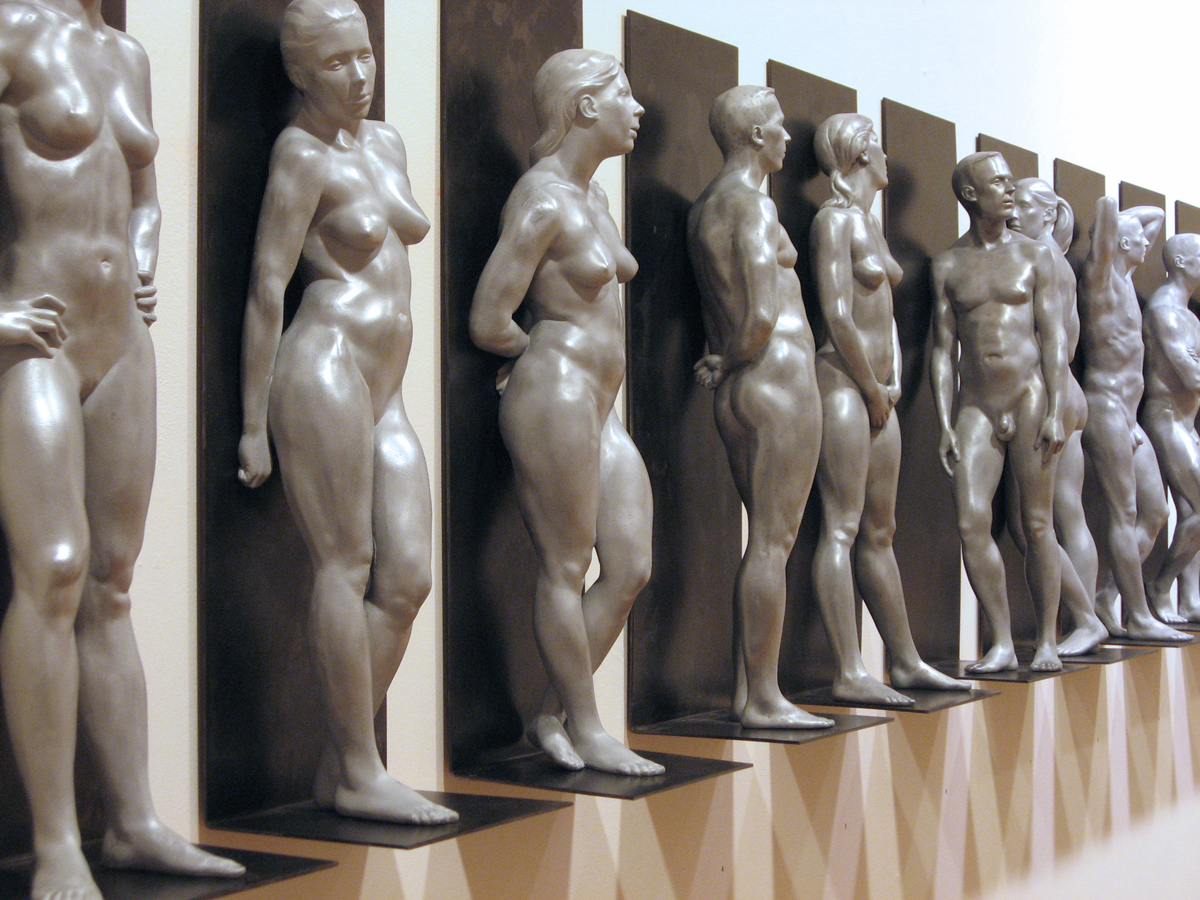
“Don’t let the perfect become the enemy of the good.” Why would anyone say that? Perfect is best, right? Think about it … what could possibly be better than perfect? How can something that is perfect be bad? Any yet we have all heard those tales and proverbs about how sometimes the right one for the job was actually the one that had flaws, that had imperfections. One tale that comes to mind is the story of the boy looking for a puppy and picking the lame runt of the litter, because he himself was small and lame. And besides, when was the last time you found a solution for a problem that was actually and literally perfect? Compromise is such a part of daily life that most of us never even notice it any more.
Art students often struggle with the need to be “perfect” when learning a new technique or starting a new piece. Their need to not make any errors at all can prevent them from making any marks at all, and they end up unproductive. Perhaps they should be introduced to the Japanese technique of “kintsugi”, the art of repairing broken pottery, usually regarded as one of the less valuables forms of trash, using gold, usually regarded as one of the most valuable of materials, thus demonstrating that injury and imperfection are as much a part of the history and identity of a thing as the design itself. Indeed, there are art techniques that deliberately introduce “stray” marks into a drawing or painting, knowing that these seeming random lines actually add visual interest to an image. One of the best teaching techniques for beginners is “blind gesture”, where the student sketches without even being able to see the paper.
Art students are not the only ones that struggle with the need to never make any mistakes. There are many who feel the constant pressure of society to conform, to be all they can be (and more), to never show any flaws or weakness. Too often people withdraw, choosing to not participate rather than take the chance on being called out for their flaws, real or perceived. While it is true that there are times that one should wait until one is ready, who was every really ready to be a parent, to get married, to start a new job, or to stand up in front of that audience and start their first comedy routine? So go ahead — learn to play the piano badly. Slop some paint around. Go down to the beach and let the sun see your winter body. Now is the perfect time to go do something imperfect.
2016-02-23

My introduction to a garden was as a place of labor. My family had an irregular patch of gravel we tilled, planted, and weeded, and which grudgingly yielded crops of various bountifulness. I truly was the living embodiment of the Biblical curse placed on Adam after expulsion from Eden. For other people, though, the idea of a garden conjures up images of idyllic scenes of rural repose: bare skin blessed by a warm sun surrounded by verdant vegetation and filled with the song of birds. I too enjoy the thought of that fantastic utopia, but I suspect those people probably never mowed an acre of lawn with a reel mower.
It is a mark of a skilled artist that they can make the difficult appear effortless. Seamless shading, exact color matching, perspective that never seems forced (unless that is what the artist wanted) and composition that always engages the eye — these are all the marks of a master. These all take time, practice, education, and just a lot of hard work. Even a talent as facile as a Mozart still must practice, practice, learn, study, and practice some more. This is true of every aspect of life, with no exception. If you want something, you have to work for it. Only then will you, or anyone else, enjoy the fruit of your labor.
2016-02-22
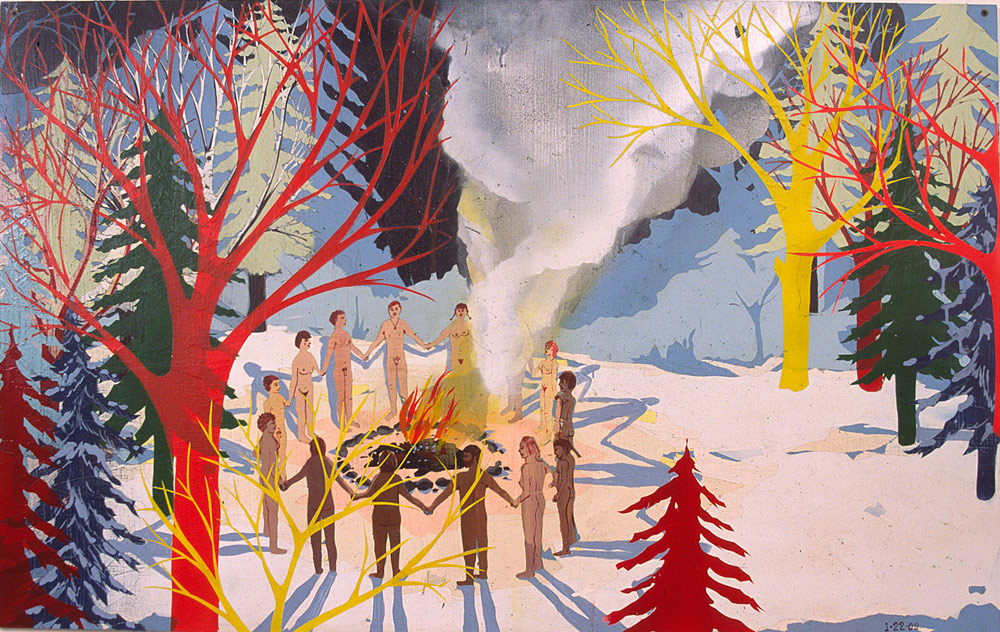
The history of the world is the history of conflict, and art reflects this. War is just the terminal phase of any clash of opposing views, and in our modern, literate era is often preceded by a flood of images, songs, productions, and writings that preach one view or the other to the men and women who will be needed to eventually enforce the ruling party’s opinions on their opponents. If society is lucky, or well-designed, then perhaps combat can be avoided. A philosophy of non-violence has been used throughout history to avoid violence while still attempting to rally support for a just cause. One non-violent technique is the use of nudity (or nakedness, depending on your definition) in protest to gain attention and increase awareness. From the Christian Freedomites in Saskatchewan and the Femen movement to the World Naked Bike Ride, protesters have bared their souls, their soles, and everything else to get their point across.
2016-02-21

The preservation and conservation of art is an entire discipline. Works of art can be damaged by fire and flood, or worn away by simple use, and special materials and techniques are required to restore the art to as close to the original state as possible. A famous example of restored art would be the Sistine Chapel in Rome. The work, done between 1984 and 1994, revealed the bright, pastel colors of the original “buon fresco” (“fresh plaster”) art, prompting critics to accuse the restorers of removing the original intent of the art. An interesting case is the copy of Rodin’s “The Thinker” owned by the Cleveland Museum of Art. Partially destroyed by a bomb in 1970, it has been left unrestored, the damage incurred becoming a part of the story of the art.
Art is not the only discipline where conservation and restoration is needed. Those of us who appreciate the chance to enjoy nature in our original natural state know that without the concerted efforts of nature conservation and even restoration our naturist opportunities would be greatly diminished. Just as art can be lost to war and societal upheaval, so also unspoiled vistas can be sold to developers or converted to shopping malls. It behooves us all to exercise the discipline of conservation and work to preserve those rights and places we value.
2016-02-20

Have things gotten better, or worse? Some folks pine for the days of yore, when men were men and women were women and small furry creatures from Alpha … well, you get the idea. Other people point out the advances in medicine and human rights and technology and claim there has never been a better time to live on the planet. Still others look into the past and see cycles, periods of advancement followed by decay and ruin, which in turn are followed by periods of advancement. Ideas crop up repeatedly, and each new generation creates their own version of what their ancestors did.Fifty years ago the Hippie movement was calling for a return to Eden, casting off their cares and clothes and running off into the woods to live as Adam and Eve. They probably did not know that they were following in the muddy footsteps of the earlier naturists from early 1900’s, who themselves were following in the footsteps of the Picards of Bohemia, who followed the Beghards in Germany, who followed the Taborites in Bohemia, all of whom echoed the early Adamites, who of course took their cue from Adam and Eve. When it comes to being naked there is nothing new under the sun. Each new movement had its own flavor — purity of faith, freedom from authority, free love, healthier living, a better tan — but all hearkened back to a simpler time and a more free lifestyle.Art has its cycles as well. With few exceptions, all techniques were known and practiced from the beginning of known history. Technology has improved the media and added a few new twists, but most everything has been done before. The idea of making reproductions of a drawing by creating a print has been around a long time. Woodcuts were the early manifestation of this technique, which has progressed through etching and lithography to linocuts and modern xerography, giclees and even 3D printing. The idea remains the same: if the original was good, why not make a copy? There are limits; even the toughest metal will eventually wear, and so later copies are not as faithful to the original as earlier copies. Clever artisans figured out ways to recreate the original and even alter or improve it. Just as in society, however, it is still true that the value of the copy depends almost entirely on the value of the original.2016-02-19

There is a purity about line. Simple marks on paper, or cuts in wood, when arranged well can create the most amazing works of art. Any one line, by itself, hardly makes anything, although in the hands of a master such a Picasso even just one line can be a work of art. When arranged by the thousands, however, simple lines blend, blur, and disappear into a larger work that can reveal truths no one else has mentioned in quite that way before.In a like manner, there is a purity of action. A simple act, well meant and well done, by itself may not mean much, although even a single act at the right time can change the world. But many people each doing one single thing can combine their small efforts together to make a larger work that can change the world, if not for everyone, at least for the many that performed that act.Think about it.2016-02-17
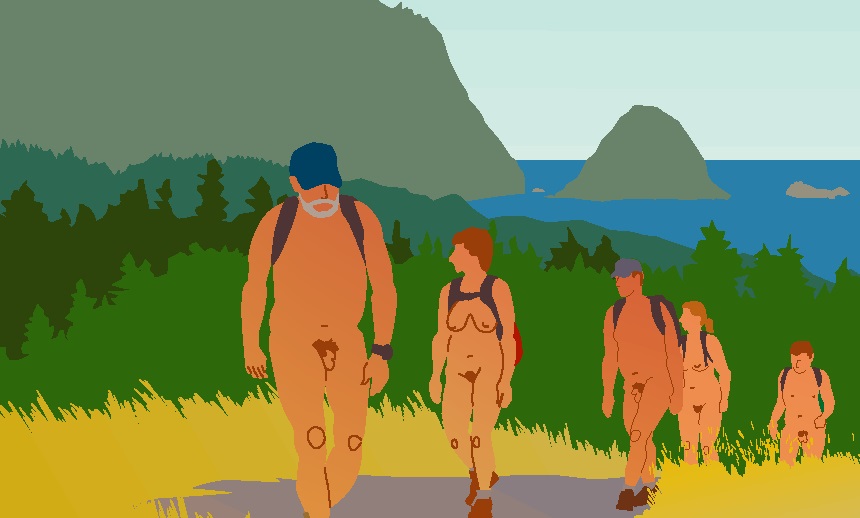
There are many places in the world that straddle the line between nature and civilization. Perhaps a well-manicured city park, or perhaps an old logging road, hacked into a wilderness to allow lumber to be pulled out to the mill. Each can have its own beauty, either heavily-hewn or trimmed to perfection, and each can provide that respite from our too-sterile lives that we need; we all need our nature fix, and often it does not matter where we get it.
Look closely at today’s image. This is not the “licked-finish” of a classical masterpiece. You can see the jagged edge of a digital drawing. Perhaps this is just an after-effect of reproduction, but it is there nonetheless. Even with it, there is still a lot to like in this picture: the composition, the color choices, the placement and posture of the figures. As a quick fix for art, this will do. It has the feeling of reality, and opens up a vista most of us will likely never experience, although some of us may get close. This image straddles the line between fine art and simple documentation, but that is okay … it is beautiful, also.2016-02-16

In every generation there is some sort of movement to “get back to the basics”, to break things down to the simplest and most basic parts. The Hippie Movement of the Sixties was one such movement, mirrored in some ways by the survivalist groups and ‘small house’ enthusiasts of today. Recurring themes are ‘back to nature’ (with the accompanying nudist urges), ‘healthy living’ (think organic food and hiking), and home education.In art there have been similar movements. Cubism, one of the most influential movements of the 20th century, focused on breaking images down to the most basic geometric shapes so that they could be reassembled in new and different ways. Picasso was a leading figure in Cubism, and many of his works epitomize the style. Not all cubist works are as abstract as his, but all share the same desire to forgo the overlying complexity and return to the basics.2016-02-15
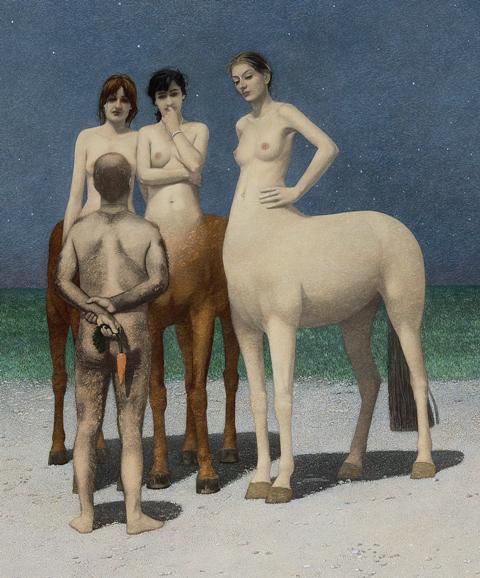
I wanted to say something profound about this image, but honestly I think this one is just fun. Is there an important message in here for all humanity? I sure there probably is, but why not just look at it and smile? Maybe you are just stopping by with a quick cup of coffee and wanted to see something for a moment. Well, here you go. Nice, isn’t it? No need to dig out the books on art theory and Greek mythology — no need to know the difference between egg-tempura and modern acrylic-based tempura — just look and enjoy.
True advocates for a naturist-based lifestyle know that there are many benefits to losing a pathological dependence on clothing. Whether you are talking about better blood circulation or increased vitamin D synthesis or even just enhanced opportunities for young people to learn about how the human body looks and functions, nudism and naturism hold a wealth of benefits. One does not need to know all those benefits, however, to enjoy the feeling of the breeze and sun on bare skin. I would say that alone is pretty profound.2016-02-14

Humans have a persistent concept of life after death and of an eternal reward. Utopia, Paradise, Valhalla, Heaven – all names for a place and a state of undying bliss in the afterlife. The cynic says this is a ploy by the establishment to control the masses, to persuade them to forgo freedom and power in this life in order to enjoy it more perfectly in the next. The believer refutes this with quotes from holy texts and appeals to civic duty. The artist responds with panoramic views of verdant open space filled with idyllic scenes of carefree, healthy nudes cavorting and gamboling under the smiling face of an indulgent sun.There have been many attempts to create Utopia here on earth, ranging from the free-love Oneida experiment in New York to the welfare-reinforced tropical community of Taylor Camp. Most have failed to cross the existential boundary of generational handover, if they even lived that long. Perhaps the most enduring examples of terrestrial paradise are nudist resorts. Established as legal entities under governmental regulation, they enjoy protection and guidance as corporations. Usually established in rural settings, many have succumbed to encroaching “civilization” and been converted to conventional, textile campgrounds or simple subdivisions.Just as, in the face of the growing environmental crisis, unspoiled nature is no longer a birthright, and instead needs to be carefully delineated and protected, so naturism is rarely freely available and must instead be carefully crafted and tended. We have as our goal the creation of urban utopias, islands of nude paradise in the encircling sea of humanity. We are looking for volunteers and donors. Something as simple as reposting our commentary and web address can help us, and we certainly would welcome more. Perhaps you feel you must wait until your life is over before you can feel the sun on your skin … but just maybe you can have a reward for building something here and now as well.2016-02-13

“There is nothing new under the sun.” King Solomon’s wisdom from Ecclesiastes seems to resound in the world of art. It seems sometimes that for any great work of art there is an earlier version created by a different artist. Indeed, today’s example is a remake of an older painting by Luca Signorelli named “The School of Pan”. The newer painting is not just a slavish replica, however; a proper artist will take the old work and make it their own. Hair styles aside, there are notable differences. The older work used drapery and foliage to appease the prudery of the day, and fashioned the titular character literally as a satyr. Ironically, the one truly nude figure in the older work was shown classically, as simple and bald as a Greek Venus. The newer version has just one figure draped, and each figure is as anatomically accurate as the style permits.Cycles also reoccur in the world of organized nudism. Society becomes more tolerant, and nudism flourishes. A generation passes and prudishness takes over, and naturist venues disappear. The difference between art and life is that the population of the planet is not ebbing and flowing, but rather increasing rapidly and irreversibly. Once isolated beaches and meadows now rest beside subdivisions, and natural hot springs dry up and vanish as developments tap their water supply and disturb their geology. If we want to continue to spend our time under the sun instead of behind closed curtains, we will need to renew the older paradigms. The age of the rural naturist venue has passed. If there are to be new naturist venues, or naturist venues at all, they will need to be urban ones. It is our goal to help design and create these. Will you join us?2016-02-12

Are you a “fellow traveler”? And if you are, is that a problem? In times of war, any citizen who does not actively participate in the dehumanization of the current adversary is immediately suspected to be in collaboration with them, typically a capital offense. Further, after victory has been achieved, any surviving citizen of the opposing nation will be judged for their association with the defeated regime, prompting efforts to distance oneself from the visible artifacts of the conquered government. Woe to any artisan whose creations were co-opted by the state in their empire-building effort.Leni Riefenstahl was one such artisan. Many view her work today and decry her as a Nazi, or at least a Nazi sympathizer, although she was never convicted or lost any of 50 libel cases. Her photos and films were certainly used as propaganda in the lead-up to the Second World War. After the conflict she remained ostracized and spent the rest of her long life trying to rehabilitate her reputation. Someone coming to her seminal work with the Nuba may view her as a naturist artist or photographer, but a deeper study of her work will certainly raise questions that may not be trivial to resolve.There is a tendency to view art in isolation from the context of its creation. After all, who has time to study the intimate details of the life of every artist? Do you really need to know the love life of Richard Wagner to enjoy the stirring strains of “Ride of the Valkyries”, or even understand the current legal challenges of Bill Cosby to laugh at the foibles of Fat Albert and the gang? How well do you need to know the character of any artist before you can allow yourself to love the image they laid on canvas? And yet it can be very hard to separate the agonized tears of a victim from the very public statement of a criminal, even if those statements do not actually relate to the crime.Today’s work is “Der Apfel des Paris” (The Apple of Paris) by Arno Breker, another German “fellow traveler”.2016-02-10

One of the key artforms of the last century was illustration, or art made to accompany another art form such as fiction. One very specific form of art that could be considered illustration is the art of the comic, or cartoon. We will be adjusting our publishing schedule to be less frequent so that we can work on producing a nudist web comic.2016-02-08

What is the difference between being naked and being nude? Even if we do not know the answer, it is often useful to ask the question. Naturism is a philosophy which seeks wellness and wholeness. Perhaps the very antithesis of naturism is violence. Often in art, nakedness is tied to violence, whereas nudity is usually associated with beauty. Nakedness has a strong association with shame, vulnerability, and weakness, whereas nudity connotes intention, confidence, and an appreciation for one’s own worth. It is vital for both the artist and the naturist to know when someone is nude, when they are naked, and to have a preference for the former over the latter.One does not need to have a degree in art or history to appreciate a beautiful painting skillfully executed; knowing history and technique increases the appreciation of fine art. This piece pays homage to many of the great art works of history as well as the history that art documented. It shows both scenes from mythology and history, as well as peeking behind the curtain at the world of the active artist, and it does so with humor. This image is very “meta”, as well as likely a self-portrait.Today’s art is “Solve et Coagula” by Dino Valls. The title of this piece come from the Latin phrase “to separate and to join together”, a key philosophy of alchemy, the mystical practice which predated science.2016-02-07
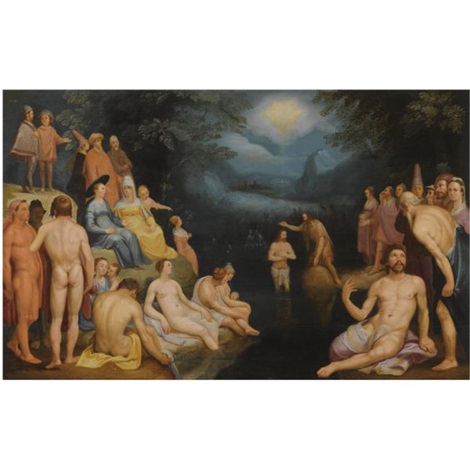
As the most important political, economic, social, and religious institution in Europe for much of the last 1500 years, Christianity has shaped art in ways that few other influences has. From the earliest era, images of Adam and Eve, the Crucifixion, and Jesus have graced the walls and halls of buildings large and small, public and private. One of the more popular themes is the baptism of Christ. It has been shown in any number of formats and media, and has reflected both the culture and scholarship of many an artistic era.
Baptism as a religious tradition predates Christianity and is simply a ritual bath. The early Church practiced it, and there are records of mass baptisms in many eras. History shows that early baptisms were more like an actual bath than today’s practice, with men, women, and children participating fully nude and fully immersed. This is reflected in some, although by no means all, art of that ritual. This tradition has largely died out as the Church has become more ossified in its thinking and practice.2016-02-06
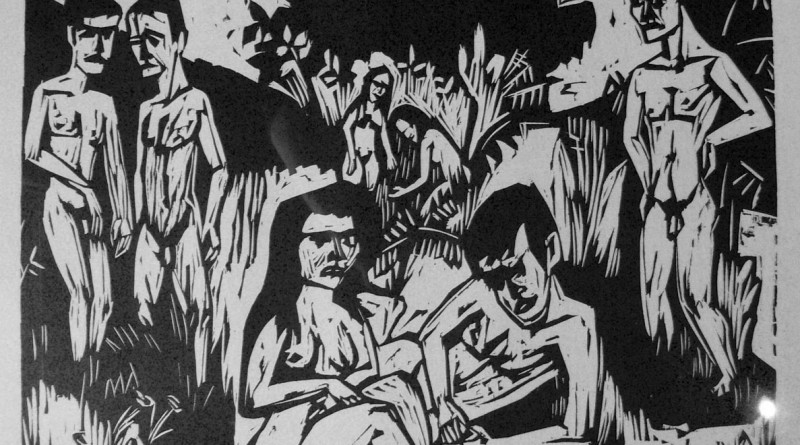
“Primitive” is a word that often carries a negative connotation. Something that has just the crude, bare essentials is often deemed “primitive”. There are other meanings to the word, however. It could mean “not derived from anything else, original”. It can also mean “from an early stage of development”. In the world of art, “primitive art” is used to refer to art that has a child-like simplicity in style or subject. Ironically, although primitive art usually appears to have been made by artists with little or no formal training, this is often not the case. Picasso said “It took me four years to paint like Raphael, but a lifetime to paint like a child.”
When a new naturist group starts up, it faces the same conundrum faced by many new organizations. It asks for volunteers, but when people come to it they see the “primitive” state it is in, and say “I will come back and volunteer when they are ready to serve a customer”. The difficulty is that once that organization is ready to serve customers, it no longer needs volunteers … it now needs customers! The world is shaped by people who are willing to work for a goal BEFORE working for that goal yields a reward. Their reward, instead, is that the world looks the way THEY want it to look. If you want the world to look a particular way, you need to be willing to build something primitive, something formative, and then perfect it.
Today’s work is “Naturalist Picnic” by Hermann Scherer. It dates to a time when the word “naturist” and the word “naturalist” were still fluid in meaning, and when the naturist movement was still primitive.2016-02-05

Every era and every generation has had its own standard for what is considered “naked”. What your grandparent considered acceptable, your child may consider outrageous, and visa versa. The same applies across cultures as well. For me, the classic example was a tale I read of a European traveler in Egypt who came across a stream where some local girls were bathing. As naked as the sun, these ladies saw the approaching stranger and immediately covered their nakedness … by placing their hands over their navels. For them, a woman was naked if you could see her bellybutton. It reminds me of a time I was visiting the home of a friend who had a small child who had stripped naked for a summer skinnydip in their wading pool. The toddler ran into the living room where we were sitting and, surprised at the company, covered her naked bottom, oblivious to the fact that her entire front side was visible. Today’s featured painting shows a standard of nudity that was somewhat acceptable in the late 1800’s and early 1900’s in America and Europe, namely a fully nude male and a topless female. Nude male bathing could be observed (and was) in public places that were visited by women and girls, most frequently urban riverbanks. This practice of public male nudity slowly ended as the First World War drew near, with the last vestiges being the nude swim classes for boys and men in high schools and YMCA’s that persisted into the 1980’s. Female toplessness was less a practice than it was a standard of art, with many public art works showing the female breasts, many examples of which survive to the present.2016-02-04

MC Escher is most widely known for his kaleidoscopic designs of infinite imagery, however, in this particular print, he uses his well-known style to depict the moment that Adam realised he and Eve were doomed for her transgression of eating ‘The Fruit of Knowledge’ and then tempting Adam with it.2016-02-03
.jpg)
Alexandre Benois lived in interesting times. Born in pre-Communist Russia, he survived the Red October revolution and died in France during the 1960’s. As an artist he had the opportunity to help color the mood of the conversation of that age. He started an art movement, curated a museum, and published a magazine. Similarly, we have the opportunity every day to shape the conversations in our lives by what we do and what we share. We are all the pigment of the painting of our age. What would you like to say?2016-02-02

“Pastoral” means anything having to do with shepherding, the craft of guiding livestock to where they can best live. By extension it has come to also refer to art or music the refers to or alludes to the countryside. Ever since the Industrial Revolution, when factories were created that required mass numbers of workers, people have been leaving the countryside for the city, to the detriment of their health, mood, and, in many cases, fortune. This has created a longing for the old days of life in the country, a luxury now afforded primarily to the wealthy or the primitive. Naturism arose in the late 19th century as a reaction to the crowded, dirty living conditions of the city and was chiefly a movement to boost people’s health.
We still find ourselves crowded into cities, with little opportunity for urban nudists to get out and practice out healthier lifestyle. It is our goal to create urban oases of nature and naturism. We cannot do this alone; we need help to create safe and healthy places for people, and to shepherd them to those places. By hook or by crook we will do this — will you help?
2016-02-01

Many folks associate art with beauty. Any art historian worth her salt will tell you that there is much more to art than smooth curves, vivid colors, and slender figures, but that is what usually sells. Similarly, most people associate youth and beauty with nudism, despite the reality that most nudists are closer to retirement than to high school and bear very little resemblance to your average supermodel. Having said that, it bears pointing out that the best artists are those who most ardently pursue perfection in their work, however they and their audience define perfection. If we as naturists want to see our movement continue to grow and thrive, we also need to pursue perfection. Unless we make our lifestyle attractive, we cannot hope to attract the new members we need to continue to enjoy the beauty of a life lived naturally.
| My Patreon Account | |
 |
We are raising money to open a studio where we can create more art! |